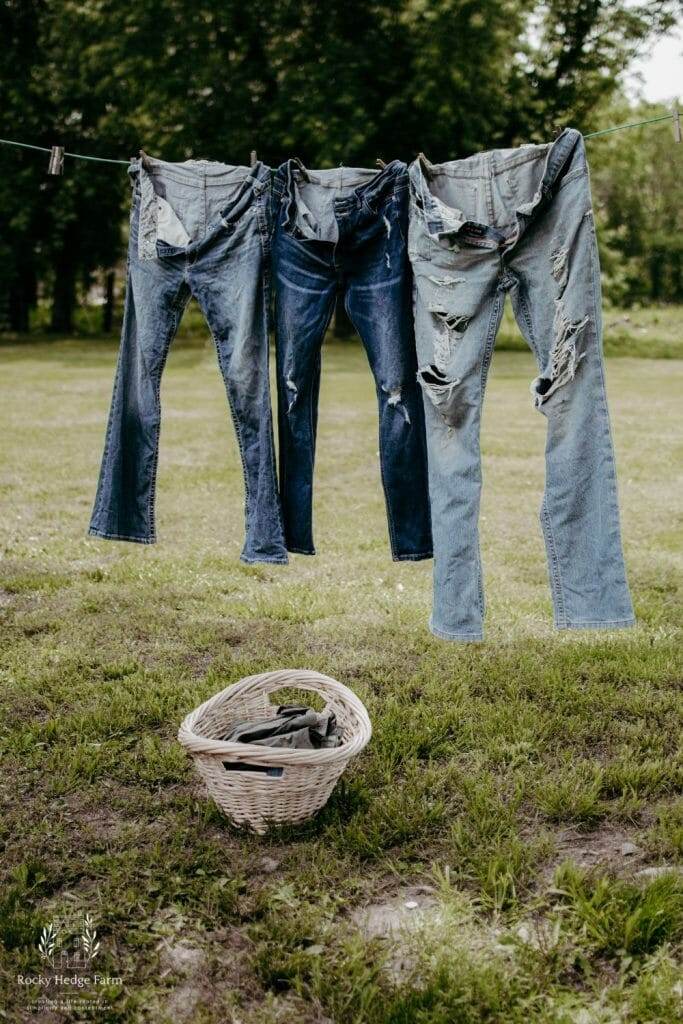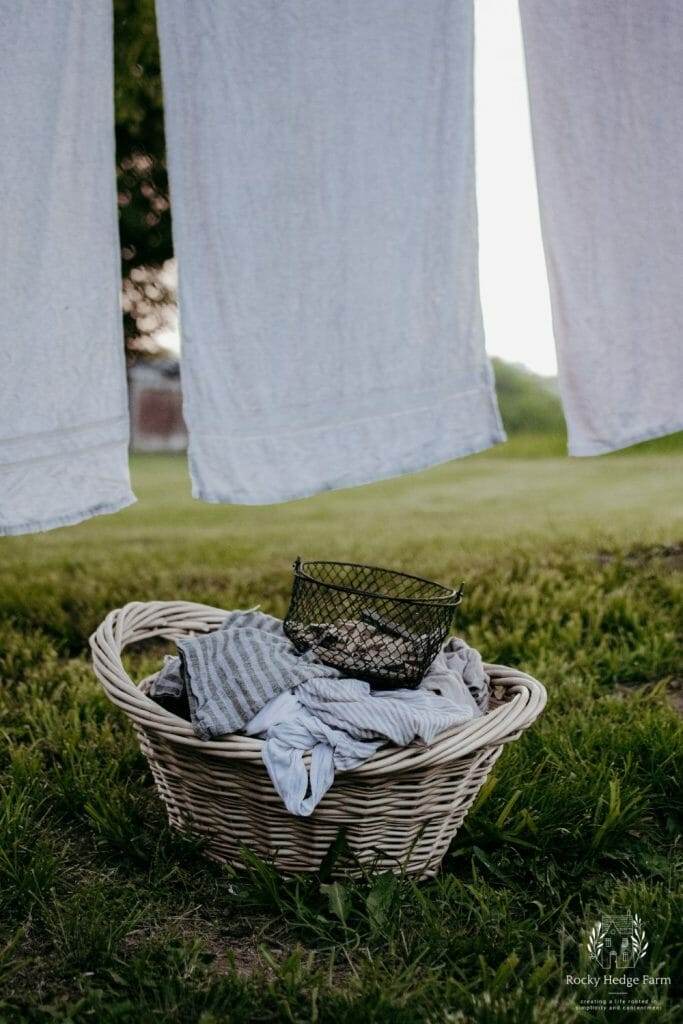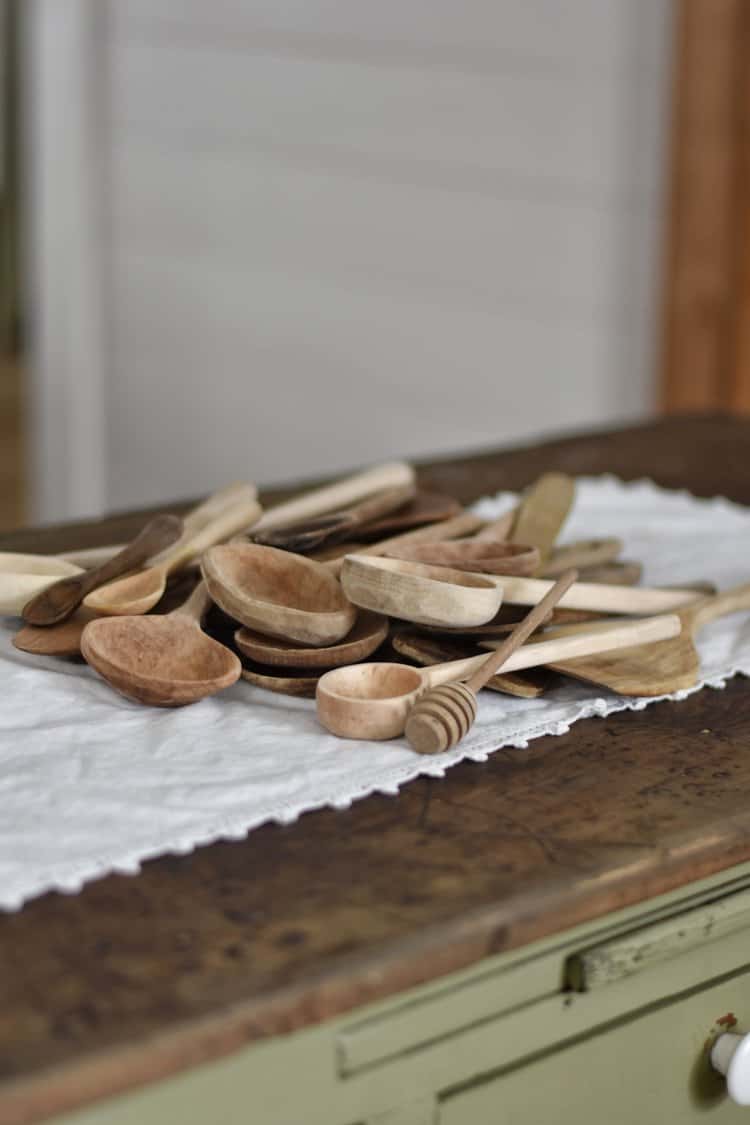Hanging Clothes on the Line the Right Way
Hanging clothes on the line the right way is a great way to dry your laundry while reaping numerous benefits. Not only does it save energy and help the environment, but it also keeps your clothes in good condition.

In the hustle and bustle of modern life, the laundry room often becomes the center of our daily tasks. Amid the constant cycle of washing, drying, and folding, a nostalgic practice offers a simpler and more sustainable approach: hanging clothes on the line.
While it may seem like a step back to the old days, there are good reasons why this age-old method still holds its charm. When you hang a load of laundry on the line, you reduce your energy consumption and embrace a more eco-friendly lifestyle.
The sun’s rays become your natural ally, gently drying your garments and infusing them with a freshness that a machine cannot replicate.
Embrace sustainability by making your own homemade laundry detergent and DIY scent booster to enhance the freshness and cleanliness of your garments.
With these eco-friendly practices, you’ll enjoy energy savings and fresh, clean, and wonderfully scented laundry.
Here are a few key techniques to remember to ensure you correctly hang your clothes on the line.

Why You Should Hang Clothes on The line
Line drying outdoors has several advantages and can be a great way to dry your clothes and linens. Here are some of the benefits of hanging clothes on a clothesline:
- Fresh-Smelling Laundry: Sunlight and fresh air can give your clothes a wonderful scent (fresh smell) that is hard to replicate with artificial fragrances.
- Natural Sanitizing and Bleaching: Sunlight has natural disinfectant properties. Sunlight can act as a natural bleaching agent, helping to remove stains and brighten white fabrics.
- Versatility: Line drying suits most washable items, including clothing, towels, bed sheets, and more.
- Wrinkle Reduction: You can often achieve a smooth finish by hanging your clothes carefully and giving them enough clothesline space to dry. This can reduce the need for ironing or even eliminate it, saving you time and effort.
- Energy and Cost Savings: Line drying is an environmentally friendly alternative to an electric dryer, as it doesn’t consume electricity or gas. By relying on natural sunlight and air, you can save energy and reduce utility bills.

Choosing a Clothesline
When it comes to hanging clothes outside, several options are available.
- Traditional Clothesline: A traditional clothesline consists of a sturdy rope or cord stretched between two supports, such as poles or trees.
- Retractable Clothesline: A retractable clothesline offers convenience and flexibility. It typically features a retractable mechanism that allows you to extend and retract the line as needed. This is particularly useful if you have limited space or prefer a neat appearance when not in use.
- Umbrella Clothesline: An umbrella clothesline features multiple lines radiating from a central pole, resembling an open umbrella. It provides significant hanging space and can be folded when unused, making it a popular choice for larger households.
- Clothes Drying Rack: A clothes drying rack is a freestanding unit with multiple tiers or rods to hang clothes. It is portable and can be easily moved around your outdoor space. Drying racks are ideal for small items or when you want to dry clothes away from direct sunlight.

What You Need For Hanging Clothes on the Line
You will need a few essential items for hanging clothes on the line. Here’s what you’ll need:
Wire Clothesline: When selecting a washing line to hang laundry on, prioritize durability by choosing materials like nylon, polyester, or cotton. Ensure that the clothesline is sturdy enough to support the weight of the wet laundry.
Clothespins: These heavy-duty wooden clothespins will keep your clothes securely in place on the line. Look for durable clothes pins made of wood or plastic.
Clothespin Container: A container or clothespin bag to store your clothes pins will keep them easily accessible while hanging your laundry.
Clothesline Clips: These clips (plastic or wooden) help hang smaller items like socks or undergarments. They prevent the items from falling off the line or getting blown away by the wind.
Hangers (optional): Ensure enough hangers are available if you prefer to hang specific garments on hangers. Plastic or wooden hangers work well for line drying.
Laundry Basket: A laundry basket simplifies carrying your clothes to and from the line. You can find different types, like plastic ones that contour to your hip, but I prefer the classic and beautiful wicker laundry basket.

Prepare the Clothesline for Clothes
Ensure the line and clothespins are clean to prepare the clothes line for effective drying. If dirt, bird droppings, or grime is on the line, wash it using ordinary detergent or a household cleaner, then rinse it thoroughly.
Allow the line to dry completely before use. Additionally, wipe down the clothespins or clips to remove any dirt or residue that may be present before hanging clothes on the line.
Next, check the tautness and strength of the clothesline. The line must be taut and securely fastened to its supports. A sagging or loose line can cause the clothes to drag on the ground.
If you have a long clothesline, you may need a prop or tensioner to support the line and keep it taut. This helps prevent sagging and ensures efficient drying.

How to Hang Clothes on A Clothesline
Hanging clothes on the clothesline is a time-honored tradition that imparts a charm to drying clothes the old-fashioned way.
Here is how to hang laundry to dry outside, focusing on different garment types.

Shirts and Blouses
Start by shaking out the shirt or blouse to remove any wrinkles. Take the garment by the tail and fold it over the clothesline, allowing the fronts opened out to the sides.
Use clothespins to secure the placket ends (the part of your shirt where the buttonholes are placed) and side seams, ensuring the garment stays in place while drying.
Another method is to take the garment by the tail and fold it over the clothesline, but this time fold the fronts inward

Dresses
For straight dresses without a full or gathered skirt, hang the dress on the clothesline by the shoulders.
For dresses with a full or gathered skirt. Turn the dress upside down and hang it by the hem on the clothesline, with the shoulders hanging down.
Dresses generally dry with fewer wrinkles and retain a better shape if you hang them on hangers.
Skirts
For straight skirts, fold the waistband over the line and secure it with clothespins at both ends.
For skirts with a gathered or full design, it’s best to hang them by the hem.

Pants and Shorts
Fold the waistband of the pants or shorts over the clothesline. Use clothespins to pin both ends of the waistband to the line for a secure hold.
T-Shirts and Undershirts
Folding the bottom hem of the T-shirt a few inches over the clothesline. Use clothespins to pin both ends of the folded hem.
Underwear or Panties
When hanging underwear or panties, fold the waist over the line and pine them by the waistband with clothespins.
However, a drying rack is a great alternative if you prefer not to hang them on the line. It provides a convenient and discreet way to hang your undergarments, keeping them separate from other laundry items.
Bras
One method is to attach clothespins to the bras by the hook end. Another option is clothesline clips designed to hang delicate garments like bras.
Socks
Use clothespins and attach socks by pinning the toe to the line. You can use clothesline clips designed for hanging socks.
Sheets
Start by folding the sheet in half lengthwise, bringing one hem to meet the other hem. Fold one of the folded hems over the clothesline, leaving a three to four-inch overhang.
Using clothespins, fasten the folded hem at both ends to the clothesline. Take the corners of the opposite hem and fold them a few inches inside the first two corners.
When hanging the sheet, make sure it opens toward the direction of the wind. This allows the wind to catch the sheet like a sail, promoting better airflow and more efficient drying.
Pillowcases
Take one side of the pillowcase opening and fold it over the clothesline. Using clothespins, fasten the folded side of the pillowcase at both corners to the clothesline.
Leave the opposite side of the pillowcase opening unfastened. This allows it to sag open, creating a sail-like effect when caught by the wind.

Towels
Before placing the towels on the line, give them a good shake. This action helps loosen the fibers resulting in softer and fluffier towels.
Then, make the towels snap to enhance their softness even more; give them a quick snap or flick with your wrist to help loosen the fibers and create a lighter texture.
To hang towels on the line, fold one end of the towel over the clothesline, leaving a three to four-inch fold. Secure the folded end by pinning it at both corners.

What Not to Hang on the Clothesline
When selecting items for line drying, certain fabrics and items are unsuitable for hanging outside. Here’s a list of what not to hang on the clothesline:
Fabrics That Will Stretch When Wet
Avoid hanging fabrics such as wool and loosely knitted articles on the clothesline. These materials tend to stretch when they become wet, which can lead to unwanted distortion and misshaping.
Wool fabrics and knit sweaters are better suited for drying on a flat surface (mesh rack) rather than hanging. When drying clothes flat, it is important to place them away from direct heat sources, as excessive heat can cause shrinking to the fabric.
Comforters or Sleeping Bags
Hanging comforters, duvet inserts, or sleeping bags on the clothesline is not advisable. The filling in these items tends to drop towards the ends, creating clumps that are difficult to dry thoroughly.
The Best Weather for Hanging Clothes on the Clothesline
The ideal weather for line drying is warm, dry, and sunny day accompanied by a gentle breeze.
These conditions facilitate quick and efficient drying of your laundry. However, it’s important to avoid extremely windy days as the constant flapping of clothes can cause wear and tear, and clothes can be blown off the line.

Tips for Line Drying Clothes on the Clothesline
When hanging clothes on the clothesline, a few tips can help you achieve the best results. Here are some helpful tips to keep in mind:
- Check the Weather: Before hanging your laundry, check the weather reports. Choose a sunny day with warm weather that is dry for optimal drying.
- Properly Sort Your Laundry: Separate your laundry into categories such as whites, colors, delicate items, and heavy fabrics. This will help prevent color bleeding.
- Prevent Fading: To prevent fading of dark-colored clothes, it’s recommended to turn them inside out before hanging them on the line. This helps protect the vibrant colors from direct exposure to sunlight, prolonging their appearance and longevity.
- Shake and Snap Towels: When taking down towels from the line, give them a good shake to fluff them up. Then, snap the towels by holding them firmly at one end and flicking them sharply. This action helps to restore their softness and fluffiness.
- Fold Laundry Immediately: Once your clean clothes are dry, promptly remove them from the line and fold them neatly. Folding dry clothes immediately helps prevent wrinkles and keeps the clothes looking fresh.
- Bring the Clothespins Inside: Exposure to outdoor elements such as rain, humidity, and direct sunlight can cause clothespins to deteriorate over time. Bringing them indoors helps protect them from unnecessary wear and tear, allowing them to last longer.
- Let the Sun Bleach Light Fabrics: Take advantage of the sun’s bleaching power if you have light-colored fabrics or white clothing that could benefit from a natural brightening effect. The sunlight can help lighten stains, naturally giving them a fresh and revitalized appearance.
- Don’t Dry Dark Fabrics in Direct Sunlight: While sunlight can benefit light fabrics, it can cause fading and discoloration in bright and dark-colored items. Opt for shaded or indoor drying areas to minimize sun exposure, and consider turning dark-colored clothing inside out before hanging them on the line.

Frequently Asked Questions
How Long Do Clothes Take To Dry Outside
On average, clothes can take a few hours to a full day to dry completely. The drying time for clothes outdoors can vary depending on various factors such as weather conditions, humidity levels, fabric thickness, and airflow.
Clothes dry faster in warm and sunny conditions with a gentle breeze. However, they may take longer to dry on cloudy or humid days.
Thicker fabrics like jeans or towels will also require more time than lighter fabrics such as t-shirts or thin dresses.
It’s important to note that hanging clothes correctly, ensuring good air flow, and spacing them out on the clothesline can help encourage a quick drying process.
How to Keep Clothes Soft When Air Drying
Vinegar Rinse: Add a cup of white vinegar (or fabric softener) to the rinse cycle. Vinegar is a natural fabric softener that can help remove any soap residue, leaving your clothes soft and fresh.
Shake Out and Fluff: Before hanging your clothes to dry, give them a good shake to loosen the fibers. This will help prevent them from becoming stiff and crunchy.
More Natural Laundry Care Posts

Remember, the laundry room isn’t just a place for functional chores; it’s an opportunity to embrace simplicity, sustainability, and a connection to a bygone era.
By hanging your clothes on the line, you not only reduce your environmental impact but also infuse your daily routine with a touch of nostalgia and authenticity.
So, next time you find yourself faced with loads of laundry, consider embracing the time-honored tradition of hanging clothes on the line—the simple act that brings us closer to nature and our roots.






I have a clothesline and love hanging my clothes on it, they smell so good and the fresh scent of the outdoors smells much longer than the dryer scent does. I think I’m the only one in my neighborhood who uses a clothesline.
So every year my neighbors know when spring is here:
Because my clothes are on the line!
I love hanging out my clothes! Never used a fabric softener of any kind cause we like out jeans crisp and our towels are like a buff puff 😁. And yes, there is a right way to hang clothes on the line. You nailed it with the pants!
I hang towels, washcloths, pillowcases, sheets, table clothes directly in half over the line, this creates a nice center fold on them and prevents any awkward stretching.